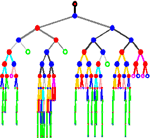Clinical decision support: projects
Work in this area focuses upon the application of evolutionary algorithms, signal processing and computer vision methods to problems in medical diagnosis and assistive technologies. We have successfully applied these methods to a number of healthcare problems, including the diagnosis and monitoring of neurological conditions (such as Parkinson's disease and Alzheimer's disease), the automated interpretation of mammograms, and the development of technologies for the rehabilitation of patients.
Monitoring Levodopa-induced Dyskinesia in Parkinson's Diesease Patients
Members: Stephen Smith
This system, employing evolutionary algorithms, is being used by Leeds General Infirmary to monitor Parkinson’s disease patients in their own homes and inform administration of their medication. The most effective form of treatment for Parkinson's Disease symptoms is a drug called levodopa, but approximately 90% of patients who take it for ten years or more develop severe side effects including involuntary movements called dyskinesia, a major source of disability severely affecting the patient’s quality of life. In conventional practice, physicians rely on patients’ own descriptions or, in severe cases, patients are admitted to hospital for several days, to monitor symptoms and adjust their medication accordingly. This system provides an objective measure of dyskinesia over extended time periods permitting a better informed course of medication, thereby reducing unplanned hospital admissions, consultations and greatly improving the patient’s quality of life.
A Unified Test for Neurodegenerative Disorders
Members: Stephen Smith
This technology employs evolutionary algorithms to differentiate Parkinson’s disease from other neurodegenerative conditions, such as Alzheimer’s disease and Lewy Body Dementia, at a stage when symptoms are often confused and a conventional diagnosis is difficult to obtain. The test, which is currently in use in hospitals in the UK, USA and UAE, can be undertaken quickly and safely, providing instantaneous feedback to health staff.
Computer-Assisted Marking of the Benson Figure Test
Members: Stephen Smith
The Benson Figure Test is used throughout the United States to asses decline in visuo-spatial ability, an important symptom of Alzheimer’s disease. However, conventional scoring of patients’ responses is subjective and therefore lacks sensitivity. Biologically inspired algorithms have been used at the UCSF and VA Medical Centers to analyse the dynamic characteristics of patients’ pen movements during the drawing process. This provides additional objective measures that are better able to detect mild impairment than the conventional scoring systems, permitting an earlier and more secure diagnosis.
Diagnosis of Neurological Disease using Evolutionary Classifiers

Members: Steve Smith, Michael Lones, David Halliday
Start Date: June 2008
This research uses novel evolutionary algorithms to induce classifiers capable of recognising the symptoms of neurological diseases such as Parkinson's and Alzheimer's. More information can be found in the following publications:
Smith, S. L. and Lones, M. A. “Implicit Context Representation Cartesian Genetic Programming for the Assessment of Visuo-Spatial Ability,” in Proc. 2009 IEEE Congress on Evolutionary Computation, May 2009.
Smith, S.L. et. al. “Diagnosis of Parkinson's Disease using Evolutionary Algorithms,” Genetic Programming and Evolvable Machines, In press, 2007.
Aly, N. M., Playfer, J. R., Smith, S. L. and Halliday, D. M., “A novel computer-based technique for the assessment of tremor in Parkinson's disease,” Age and Ageing, doi:10.1093, June 2007.
Allen, D.P., Playfer, J.R., Aly, N.M.,. Duffey, P., A. Heald, A., Smith, S.L. and Halliday, D.M., "On the use of low-cost computer peripherals for the assessment of motor dysfunction in Parkinson’s disease" IEEE Trans. Neural Systems & Rehabilitation Engineering, Vol.15, No.2, 286-294, 2007.
Smith, S.L. et. al. “The Application of Evolutionary Algorithms towards the Diagnosis of Parkinson's Disease,” GECCO Workshop on Medical Applications of GEC, Seattle, July, 2006.
Allen, D.P., Halliday, D.M., Smith, S.L., Playfer, J. & Aly, N. "A clinical diagnostic tool for the assessment of bradykinesia in Parkinson’s disease using using low cost computer peripherals," Institute of Physics and Engineering in Medicine, Annual Scientific Meeting, 34, 2005.
Objective Diagnosis of Parkinson’s Disease
Members: Stephen Smith
This novel non-invasive device, currently installed in hospitals in the UK, USA, UAE and Australia, confirms diagnosis of Parkinson's Disease by using evolutionary algorithms to assess digital measurements taken from patients performing a simple finger tapping test used in conventional clinical evaluation. This allows microscopic movements, invisible to the human eye, to be identified that characterise the symptoms of Parkinson’s disease in a way that has not previously been possible.
Implicit Context Representation for Evolutionary Computation

Members: Michael Lones, Andy Tyrrell, Steve Smith
Start Date: October 2000
Implicit context is a novel approach to representing evolving structures in which structural components describe their interactions using functional descriptions of other components. In conventional structural representations, these interactions are described using positional information. However, positional information is not generally conserved between solutions and between generations, leading to disruptive effects when genetic operators are applied. This can be seen in genetic programming, where sub-tree crossover does not typically carry out useful behaviour. Enzyme genetic programming is a form of genetic programming which uses implicit context representation, and has shown behavioural and performance benefits when applied to a range of problems. More recently, we have also shown how implicit context may be implemented within cartesian genetic programming. Application domains include digital circuit design, image filter design, and finite state automata induction.
Recent Publications
Positional Independence and Recombination in Cartesian Genetic Programming
X. Cai, S. L. Smith and A. M. Tyrrell, European Conference on Genetic Programming (EuroGP), LNCS 3905:351-360, 2006.
An Implicit Context Representation for Evolving Image Processing Filters
S. L. Smith, S. Leggett and A. M. Tyrrell, EvoWorkshops2005, LNCS 3449:407-416, 2005.
Enzyme Genetic Programming: Modelling Biological Evolvability in Genetic Programming
Michael Adam Lones, Ph.D. Thesis, Department of Electronics, University of York, 2004.
Modelling Biological Evolvability: Implicit Context and Variation Filtering in Enzyme Genetic Programming
M. A. Lones and A. M. Tyrrell, BioSystems 76(1-3):229-238, August-October 2004.
